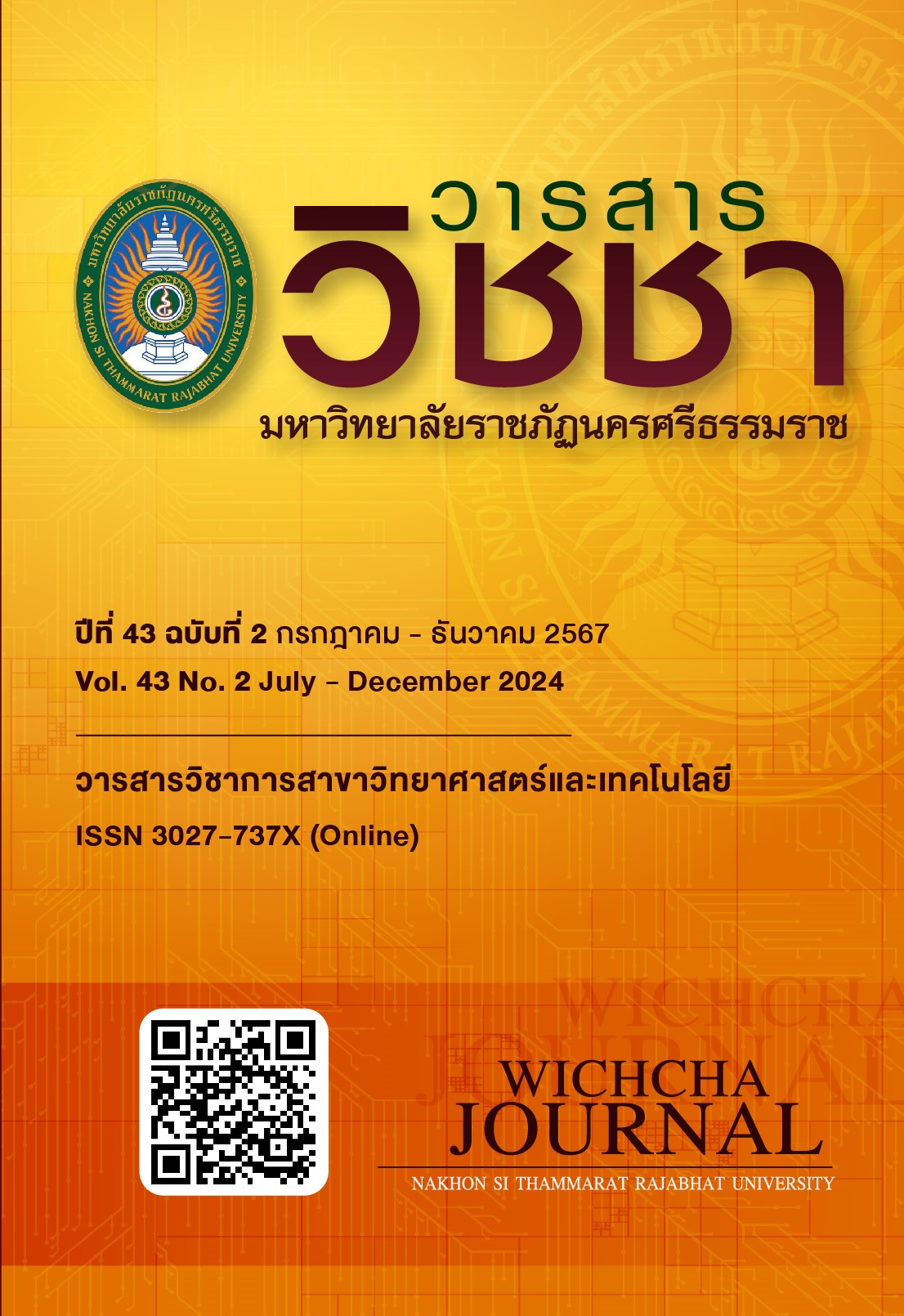การศึกษาจลนพลศาสตร์และอุณหพลศาสตร์ของการย้อมสีสกัดจากเปลือกหุ้มเมล็ดโกโก้บนผ้าฝ้าย
Main Article Content
บทคัดย่อ
งานวิจัยนี้ศึกษาจลนพลศาสตร์และอุณหพลศาสตร์ของการดูดซับสีย้อมจากเปลือกหุ้มเมล็ดโกโก้ (extracted cocoa husk: ECH) บนผ้าฝ้าย โดยใช้อะลูมิเนียมไอออน (Al3+) เป็นสารช่วยติดสี โดยการย้อมสีพร้อมกับสารช่วยติดสี (meta-mordanting) ทำการสกัดสีจากเปลือกหุ้มเมล็ดโกโก้ด้วยน้ำและทำให้แห้งแบบแช่เยือกแข็ง (freeze drying) จะได้ผงสีน้ำตาล จลนพลศาสตร์ของการดูดซับสีย้อมจากเปลือกหุ้มเมล็ดโกโก้บนผ้าฝ้ายสอดคล้องกับสมการอันดับสองเทียม (pseudo second-order) ซึ่งชี้ให้เห็นว่าเป็นการดูดซับทางเคมี (chemisorption) นอกจากนี้ศึกษาปัจจัยทางอุณหพล-ศาสตร์พบว่าค่าการเปลี่ยนแปลงพลังงานอิสระกิบส์ (∆G°) เป็นลบ แสดงให้เห็นว่าการดูดซับสีย้อมจากเปลือกหุ้มเมล็ดโกโก้บนผ้าฝ้ายเป็นกระบวนที่เกิดขึ้นได้เอง ค่าการเปลี่ยนแปลงเอนทาลปี (∆H°) และการเปลี่ยนแปลงเอนโทรปี (∆S°) เป็นบวก แสดงว่าการดูดซับสีย้อมเป็นแบบดูดความร้อน และการดูดซับทำให้ระบบมีความไม่เป็นระเบียบเพิ่มขึ้น ตามลำดับ
Article Details

This work is licensed under a Creative Commons Attribution-NonCommercial-NoDerivatives 4.0 International License.
เนื้อหาและข้อมูลในบทความที่ลงตีพิมพ์ในวารสารวิชชา มหาวิทยาลัยราชภัฏนครศรีธรรมราช ถือเป็นข้อคิดเห็นและความรับผิดชอบของผู้เขียนบทความโดยตรง ซึ่งกองบรรณาธิการวารสารไม่จำเป็นต้องเห็นด้วยหรือร่วมรับผิดชอบใด ๆ
บทความ ข้อมูล เนื้อหา รูปภาพ ฯลฯ ที่ได้รับการตีพิมพ์ในวารสารวิชชา มหาวิทยาลัยราชภัฏนครศรีธรรมราช ถือเป็นลิขสิทธ์ของวารสารวิชชา มหาวิทยาลัยราชภัฏนครศรีธรรมราช หากบุคคลหรือหน่วยงานใดต้องการนำข้อมูลทั้งหมดหรือส่วนหนึ่งส่วนใดไปเผยแพร่ต่อหรือเพื่อการกระทำการใด ๆ จะต้องได้รับอนุญาตเป็นลายลักษณ์อักษรจากวารสารวิชชา มหาวิทยาลัยราชภัฏนครศรีธรรมราชก่อนเท่านั้น
The content and information in the article published in Wichcha journal Nakhon Si Thammarat Rajabhat University, It is the opinion and responsibility of the author of the article. The editorial journals do not need to agree. Or share any responsibility.
References
กรมวิชาการเกษตร. (2564). การจัดการความรู้ เทคโนโลยีการผลิตโกโก้. นนทบุรี: การันตี.
ประกิต ไชยธาดา. (2562). ผลของตัวทำละลายและความเป็นกรด-ด่างต่อปริมาณและความคงตัวของสารสีที่สกัดได้จากพืช. วารสารวิชชา มหาวิทยาลัยราชภัฏนครศรีธรรมราช, 38(1), 65-78.
Adeel, S., Zia, K.M., Abdullah, M., Rehman, F., Salman, M. and Zuber, M. (2019). Ultrasonic assisted improved extraction and dyeing of mordanted silk fabric using neem bark as source of natural colorant. Natural Product Research, 33(14), 2060-2072, doi: https://doi.org/10.1080/14786419.2018.1484466.
Al-Kadhi, N.S. (2019). The kinetic and thermodynamic study of the adsorption lissamine green b dye by micro-particle of wild plants from aqueous solutions. Egyptian Journal of Aquatic Research, 45(3), 231-238, doi: https://doi.org/10.1016/j.ejar.2019.05.004.
Balentic, J.P., Ackar, D., Jokic, S., Jozinovic, A., Babic, J., Milicevic, B., Šubaric, D. and Pavlovic, N. (2018). Cocoa shell: A by-product with great potential for wide application. Molecules, 23(6), doi: https://doi.org/10.3390/molecules23061404.
Hamid, N. and Munaim, M.S.A. (2017). An adsorption kinetic and thermodynamic study of dyeing betacyanin extract from dragon fruit skin onto the spun silk and acrylic yarn. Australian Journal of Basic and Applied Sciences, 11(4), 33-41.
Islam, S and Sun, G. (2017). Thermodynamics, kinetics, and multifunctional finishing of textile materials with colorants extracted from natural renewable sources. Sustainable Chemistry and Engineering, 5(9), 7451-7466, doi: https://doi.org/10.1021/acssuschemeng.7b01486.
Jabar, J.M., Adedayo, T.E. and Odusote, Y.A. (2021). Green, eco-friendly and sustainable alternative in dyeing cotton fabric using aqueous extract Mucuna slonaei F dye: Effects of metal salts pre-mordanting on color strength and fastness properties. Current Research in Green and Sustainable Chemistry, 4, doi: https://doi.org/10.1016/j.crgsc.2021.100151.
Kheddo, A., Rhyman, L., Elzagheid, M.I., Jeetah, P. and Ramasami, P. (2020). Adsorption of synthetic dyed wastewater using activated carbon from rice husk. SN Applied Sciences, 2, doi: https://doi.org/10.1007/s42452-020-03922-5.
Mia, R., Islam, M., Ahmed, T., Waqar, A., Khanam, N.J., Sultana, S., Bhuiyan, S.K. and Uddin, N. (2022). Natural dye extracted from Triadica sebifera in aqueous medium for sustainable dyeing and functionalizing of viscose fabric. Cleaner Engineering and Technology, 8, doi: https://doi.org/10.1016/j.clet.2022.100471.
Pisitsak, P., Hutakamol, J., Thongcharoen, R., Phokaew, P., Kanjanawan, K. and Saksaeng, N. (2016). Improving the dyeability of cotton with tannin-rich natural dye through pretreatment with whey protein isolate. Industrial Crops and Products, 79, 47-56, doi: https://doi.org/10.1016/j.indcrop.2015.10.043.
Punrattanasin, N., Nakpathom, M., Somboon, B., Narumol, N., Rungruangkitkrai, N. and Mongkholrattanasit, R. (2013). Silk fabric dyeing with natural dye from mangrove bark (Rhizophora apiculata Blume) extract. Industrial Crops and Products, 49, 122-129, doi: https://doi.org/10.1016/j.indcrop.2013.04.041.
Rojo-Poveda, O., Barbosa-Pereira, L., Zeppa, G. and Stévigny, C. (2020). Cocoa bean shell-a by-product with nutritional properties and biofunctional potential. Nutrients, 12(4), doi: https://doi.org/10.3390/nu12041123.
Shabbir, M., Rather, L.J., Islam, S., Bukhari, M.N., Shahid, M., Khan, M.A., Mohammad, F. (2016). An eco-friendly dyeing of woolen yarn by Terminalia chebula extract with evaluations of kinetic and adsorption characteristics. Journal of Advanced Research, 7(3), 473-482, doi: https://doi.org/10.1016/j.jare.2016.03.006.
Tounsadi, H., Metarfi, Y., Barka, N., Taleb, M. and Rais, Z. (2020). Removal of textile dyes by chemically treated sawdust of acacia: kinetic and equilibrium studies. Journal of Chemistry, 2020, doi: https://doi.org/10.1155/2020/7234218.

